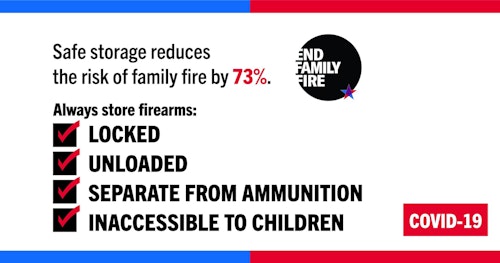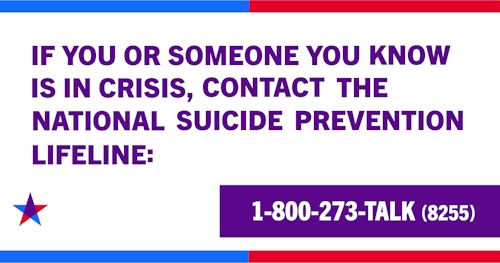From gun locks to safes, there is a wide variety of effective ways to store your guns safely that can be tailored to your specific household and family circumstances. Here are steps you can take to protect family, friends, and even yourself from family fire.
Always store guns unloaded, locked, separately from ammunition, and inaccessible to children and other at-risk individuals.
Kids and teens are naturally curious, especially when it comes to things they have been told not to handle. Although teaching children about gun safety has value, parents cannot rely on safety training alone if they want to ensure that their kids do not handle guns unsupervised. The practices of keeping your firearm unloaded and locked are associated with significantly decreased risks of family fire.

Encouraging gun owners who live in homes with children and teens to lock all household firearms could result in significant reductions in youth firearm mortality. New research estimates that if just 50% of households with children switched from keeping their guns unlocked to storing all firearms locked, more than 200 youth suicides and unintentional deaths could be prevented each year.
It’s also important to consider that access to guns increases the odds of a fatal suicide attempt. Most of the guns used in suicides come from the victim’s or a family member’s home. When someone is in crisis, having barriers in place that delays access to a lethal method can prevent a person from ending their life. Many suicide attempts happen with little planning in response to a short-term crisis. Firearms are a highly lethal method, meaning that the odds of survival are very low. This is why the risk of suicide is three times greater for someone living in a house with loaded firearms than among those in homes with unloaded guns.
THE SUICIDE PREVENTION LIFELINE: 1-800-273-8255
VETERANS CRISIS LINE: 1-800-273-8255 PRESS 1
CRISIS TEXT LINE: Text HOME to 741741

Store ammunition separately from its gun
About 4.6 million kids live in homes with at least one unlocked and loaded firearm. Storing ammunition separately from a gun reduces the risk of family fire.
Storage options
Research the various gun storage options available to determine which is best suited for your household. Trigger locks and cable locks prevent a firearm from being fired until the device is unlocked and removed from the firearm.
- Trigger locks: External locks that are attached directly to the firearm.
- Cable locks: Threaded through the chamber of the firearm, keeping the chamber open and empty.
Lock boxes, carrying cases, and safes can help protect firearms from damage. Some safes offer biometric technology, which only recognizes and opens with your unique fingerprint. Biometric technology also allows for quick access.
- Lock boxes and gun carrying cases should include one of the following: an external lock paired with physical keys, electronic combination lock, or a fingerprint-recognition lock.
- Gun safes: Ranging in size, they allow you to safely store more than one firearm at a time.
Learn more about safe firearm storage options.
If traveling, transport your gun locked inside a cool, clean, dry carrying case or storage box.
When transporting a firearm, take the same precautions you do while in your home. Unintentional shootings can happen anywhere — so it is important to ensure your gun is stored in a locked container, ideally secured to the frame of your car. Research the various cases and safes specifically designed for your car to find the best option for you.
Remember: Storing guns in glove boxes or trunks without any additional precautions is not recommended, as both can easily be broken into.
If you happen to let another person drive your car, ensure that they know you keep your firearms inside, or consider removing the firearms altogether before you give another person access to your vehicle.
For information on how to travel safely with firearms at airports, The Transportation Security Administration has specific guidelines for transporting firearms and ammunition through airports and on commercial aircraft.
In addition to storing your guns safely, ACTing responsibly means practicing firearm safety tips to prevent family fire
Act responsibly and always practice the following firearm safety tips.
- Treat every gun as if it is loaded
Always treat your gun as if it could fire at any time. Even when cleaning or transporting your gun, accidents can — and do — happen. Many people have been unintentionally injured or killed because they assumed their gun was unloaded — treating every gun as if it is loaded will help prevent those injuries. - Know your target and what lies beyond it. Only point your gun at something you intend to shoot, and maintain control over the muzzle of your gun at all times.
Ensure complete awareness for not just your target but what surrounds it as well. When using your gun, it is critical that you only point your gun at its intended target. - Keep your finger off the trigger until you intend to fire.
Only put your finger on the trigger when you have identified your target and are ready to fire. - Keep your gun’s “safety” on until you intend to fire, but do not solely rely on your gun’s “safety” feature.
The “safety” on a gun is a feature that should serve as a supplement to proper gun handling, but it is not a replacement for responsible firearm use. Like any mechanical device, a safety feature could easily become inoperable. - Use the correct ammunition.
There are many kinds of firearms and ammunition available, making it critical to match your ammunition with the right rifle, shotgun, or handgun. To ensure that you are using the proper caliber or gauge for your specific firearm, review the gun’s instruction manual as well as the manufacturer’s markings on the gun itself. Be sure to read the information on the lid of the box of ammunition. Using the wrong ammunition will damage your firearm and potentially cause serious injury, as the barrel of the gun can explode. - Firearms should be unloaded when not in use.
We know that kids are curious and they can get into everything. To protect our kids and ensure that our homes are safe, act responsibly and ensure all guns are unloaded when they are not in use. - Only use a firearm when you are in full control of your body: Never consume alcohol before or while you handle a firearm.
You wouldn't let your friend drive drunk, so why would you let them use their gun after drinking? Guns, like cars, have the capacity to do great harm and require full awareness to operate properly. As an issue of public safety, we must do our part to ensure that we are keeping our communities safe — don’t drink and carry. - Engaging in shooting sports? Use the proper ear and eye protection.
The best way to protect from any eye or ear injuries at the shooting range or in the field is to use the proper safety gear. It’s easy to purchase, relatively inexpensive, and will help protect our families. - Maintain high machine function for your firearm: Don’t alter or modify your gun and ensure it is regularly serviced.
Clean your guns after each use and make sure that the barrel of your gun is clear of any obstructions before shooting. Keep your firearms in high-working order to ensure proper usage. - If your gun is not firing when the trigger is pulled, handle with care and don’t attempt to fire again.
Consider home security alternatives
If you are not confident or have doubts about gun ownership, consider other options. Home security systems, alarms, and guard dogs are all possible alternatives. When considering having a firearm in the house, think about family circumstances and individual risk factors.
- Monuteaux, Michael C., Deborah Azrael, and Matthew Miller. “Association of Increased Safe Household Firearm Storage With Firearm Suicide and Unintentional Death Among US Youths.” JAMA Pediatrics 173, no. 7 (January 2019): 657.
- Holly, Cheryl, Sallie Porter, Mary Kamienski, and Aubrianne Lim. “School-Based and Community-Based Gun Safety Educational Strategies for Injury Prevention.” Health Promotion Practice 20, no. 1 (2018): 38–47.
- Monuteaux, Michael C., Deborah Azrael, and Matthew Miller. “Association of Increased Safe Household Firearm Storage With Firearm Suicide and Unintentional Death Among US Youths.” JAMA Pediatrics 173, no. 7 (January 2019): 657.
- Simon, Thomas R., Alan C. Swann, Kenneth E. Powell, Lloyd B. Potter, Marcie-Jo Kresnow, and Patrick W. Ocarroll. “Characteristics of Impulsive Suicide Attempts and Attempters.” Suicide and Life-Threatening Behavior 32 (2002): 49–59.
- Grossman, David C., Donald T. Reay, and Stephanie A. Baker. “Self-Inflicted and Unintentional Firearm Injuries Among Children and Adolescents.” Archives of Pediatrics & Adolescent Medicine153, no. 8 (January 1999): 875.
- Spicer, Rebecca, and Ted Miller. “Suicide Acts in 8 States: Incidence and Case Fatality Rates by Demographics and Method.” American Journal of Public Health 90, no. 12 (December 2000): 1885–91.
- Spicer, Rebecca, and Ted Miller. “Suicide Acts in 8 States: Incidence and Case Fatality Rates by Demographics and Method.” American Journal of Public Health 90, no. 12 (December 2000): 1885–91.
- Kellermann, Arthur L., Frederick P. Rivara, Grant Somes, Donald T. Reay, Jerry Francisco, Joyce Gillentine Banton, Janice Prodzinski, Corinne Fligner, and Bela B. Hackman. “Suicide in the Home in Relation to Gun Ownership.” New England Journal of Medicine 327, no. 7 (1992): 467–72.
- Azrael, Deborah, Joanna Cohen, Carmel Salhi, and Matthew Miller. “Firearm Storage in Gun-Owning Households with Children: Results of a 2015 National Survey.” Journal of Urban Health 95, no. 3 (2018): 295–304.
The End Family Fire campaign is a part of the Brady Center's C(3) efforts.


